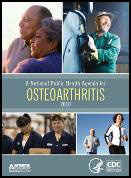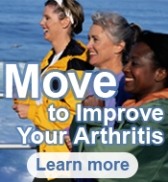On this Page
Arthritis Policy: Strategic Directions
Public health policy—including laws, regulations, standards, resolutions, and guidelines—is a growing focus within the public health community because it can be an effective, low cost, sustainable approach to improve health. Policy change strategies expand the public health framework for arthritis and can be implemented at a variety of levels and by a variety of entities and partners. They also have the potential to improve arthritis health outcomes in large populations, much like policies have been effective in addressing other public health issues such as smoking and injury. A range of issues can be addressed through policies and by changing physical and social environments, from quality of life to disease management to dissemination of evidence-based interventions. Policy strategies for arthritis also have the potential to positively impact chronic conditions that commonly co-occur with arthritis, such as diabetes, heart disease, and obesity.
Read more about the CDC Arthritis Program's policy activities and documents.
 Policy Briefs
Policy Briefs
- Managing Arthritis: Improving Lives—(National Conference of State Legislatures Legisbrief. Briefing Papers on Important Issues of the Day. June–July 2011, Vol. 19, No. 30.):
This policy brief for legislators provides an overview of the public health problem of arthritis, including discussions of the costs associated with arthritis, arthritis prevalence and impact, and the most common chronic conditions that occur with arthritis. Highlights are provided of both state and federal action. The full text of the Legisbrief is available [PDF - 259KB].
Read more information about the National Conference of State Legislatures.
- Reducing the Impact of Arthritis—(Council of State Governments):
This policy brief includes a personal story of how exercise positively affects the life of a woman with arthritis. Talking points are also on arthritis, including reasons for concern, costs of arthritis, effects of arthritis, public health policies that work to reduce the effects of arthritis, and what state legislators can do are included. Examples of state legislative action to address arthritis are also provided. The full text of the policy brief may be accessed here [PDF - 376KB].
Read more information about the Council of State Governments.
Policy Position Documents
 A National Public Health Agenda for Osteoarthritis
A National Public Health Agenda for Osteoarthritis
A National Public Health Agenda for Osteoarthritis (2010) was developed by more than 70 stakeholders following a call-to-action led by the Arthritis Foundation and CDC. A National Public Health Agenda for Osteoarthritis sets the stage for a collaborative and focused action to achieve the following three overall goals during the next 3 to 5 years:- Ensure the availability of evidence-based intervention strategies; such as, self management education, physical activity, injury prevention, and weight management, and healthy nutrition to all Americans with osteoarthritis (OA).
- Establish supportive policies, communication initiatives, and strategic alliances for OA prevention and management.
- Initiate needed research to better understand the burden of OA, its risk factors, and effective strategies for intervention.
The Agenda for OA is geared to serve as a blueprint for action and sets forth 10 strategy recommendations to reduce OA symptoms such as pain, disability, and loss of function. More information and the full text of the agenda is available.
 National Arthritis Action Plan: A Public Health Strategy
National Arthritis Action Plan: A Public Health Strategy
The National Arthritis Action Plan (NAAP)(1999) was developed by the Arthritis Foundation, the Association of State and Territorial Health Officials, and the Centers for Disease Control and Prevention (CDC) in collaboration with a wide variety of public and private partners.
The NAAP has the following six aims:
- Increase public awareness of arthritis as the leading cause of disability and an important public health problem.
- Prevent arthritis whenever possible.
- Promote early diagnosis and appropriate management for people with arthritis to ensure the maximum number of years of healthy life.
- Minimize preventable pain and disability due to arthritis.
- Support people with arthritis in developing and accessing the resources they need to cope with their disease.
- Ensure that people with arthritis receive the family, peer, and community support they need.
- Arthritis At-A-Glance: Meeting the Challenge, 2011 CDC
The annual CDC Arthritis-At-A-Glance provides a current, comprehensive overview of CDC Arthritis Program activities, including science and epidemiology activities and data updates; key public health messages and management strategies; state program funding initiatives; policy, partnership, and communication activities; funded state and partner success stories; and future program directions. Read the complete Arthritis At-A-Glance.
- Current Efforts—Policy and Environmental Strategies to Increase Physical Activity among Adults with Arthritis
The CDC Arthritis Program and the Arthritis Foundation have collaborated to identify policies and environmental strategies for increasing physical activity among adults with arthritis. This project was prompted by a lack of current policies and environmental strategies for increasing physical activity that specifically address arthritis.
Individuals with arthritis have disease specific barriers to being physically active as well as high rates of other chronic diseases that also are associated with physical inactivity. Physical activity is beneficial for adults with arthritis, yet despite these benefits; adults with arthritis have higher rates of physical inactivity than those without arthritis. This initiative focuses on increasing physical activity because of the many benefits for adults with arthritis, the unique role policy and environmental strategies can have in addressing arthritis specific barriers to physical activity, and the other long-established benefits physical activity has for co-occurring chronic conditions such as obesity, diabetes, and heart disease. The policies and environmental strategies are designed to address the unique barriers adults with arthritis face with physical activity.
Policy Activities
- Osteoarthritis Action Alliance
The Osteoarthritis (OA) Action Alliance is a national coalition of concerned organizations mobilized by the Arthritis Foundation and CDC. This coalition is committed to elevating OA as a national health priority and promoting effective policy solutions that aim to address the individual and national toll of OA. In addition, the OA Action Alliance, with the public health community, is working to ensure people with OA have the access, skills, and capacity to benefit from effective and proven interventions.
The mission of the OA Action Alliance is to work collectively to advance the recommendations outlined in A National Public Health Agenda for Osteoarthritis [PDF - 175KB] by promoting action to prevent and control OA and its progression through proven interventions, public policies, communication strategies and enhanced research initiatives. For more information about the work of the Alliance and how to join, visit the Osteoarthritis Action Alliance or CDC Arthritis Program.
Get email updates
To receive email updates about this page, enter your email address:

Contact Us:
- Arthritis Program
Mailstop K-51
4770 Buford Hwy NE
Atlanta, GA 30341-3724
- Phone: 770.488.5464
Fax: 770.488.5964 - cdcinfo@cdc.gov


